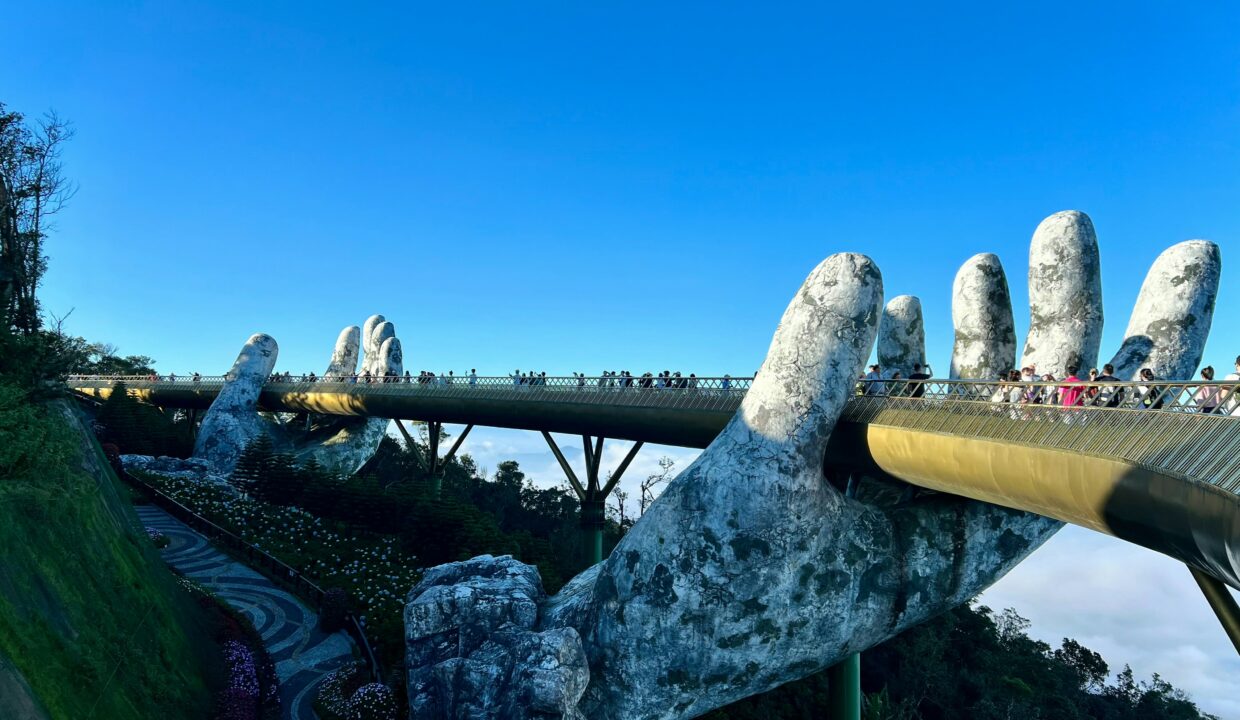Moving to Da Nang in 2026? Must-read before booking your tickets
You’ve seen the artistic shots. The view of the Golden Bridge, the fire show of the Dragon Bridge, the endless stretch of My Khe Beach. You’ve heard the hype online, the claims that Da Nang is the “most livable city in Vietnam,” a digital nomad paradise where the cost of living is low and the quality of life is high.
Some of that is true. A lot of it is outdated marketing.
The Ultimate Guide for Moving to Da Nang: A No-BS Handbook from a 7-Year Expat
I’m writing this as I head into my 7th year living in Da Nang. I’ve witnessed this city’s weekly transformations—from the tight-knit, pre-COVID community where good Western food was a treasure hunt, to the eerie silence of lockdown, and now to the post-COVID boom where everything is accelerating: prices, opportunities, and the sheer number of people discovering this place.
The internet is littered with conflicting information, sketchy rental websites, and advice from people who spent a week here on a tourist visa. This is not that. This is a deep, comprehensive, and brutally honest guide for anyone seriously considering making Da Nang their home. We’ll dig into the questions you’re actually asking and provide answers based on years of on-the-ground experience.
Why is Da Nang popular? The real reasons
It’s not just the beach. The true appeal of Da Nang lies in its unique balance—a “Goldilocks” effect that few other cities in Southeast Asia can match:
- The “Just Right” Size: It’s a proper city with an international airport, modern infrastructure, and diverse amenities, but you can cross it on a motorbike in 20-30 minutes. It has the energy of a growing metropolis without the soul-crushing traffic and pollution of Hanoi or Ho Chi Minh City.
- Infrastructure & Forward-Thinking Leadership: Da Nang is famously well-organized for a Vietnamese city. The roads are wide, the city is relatively clean, and there’s a tangible sense of forward momentum. Local government has actively pushed for tech investment and tourism development, making it a hub for both.
Fun Fact: Da Nang infrastructure has been built to accommodate 3 million people, yet current population is 1.5 million only. - Unbeatable “Work-Life” Geography: Where else can you finish your work call at 5 PM, and by 5:15 PM, be surfing, hiking up a mountain, or playing golf at a world-class course? The proximity of the city, the sea, and the mountains (Son Tra Peninsula) is unparalleled. This accessibility to nature and recreation is a core part of the lifestyle.
- A Hub for Central Vietnam: Da Nang is the perfect base camp. The ancient town of Hoi An is a 45-minute drive south. The imperial city of Hue is a 2-hour scenic drive over the Hai Van Pass. You have an entire region of culture and history at your doorstep.
- Great International Connectivity: Direct flights to other destination in Asia, such as Hong Kong, Singapore, Taipei or Korea are often and affordable. Perfect for city breaks, visa runs or a longer get-away.
Why Should You Consider Moving to Da Nang?
Beyond its general popularity, moving here is a specific lifestyle choice. You should seriously consider it if:
- You Prioritize a Balanced Lifestyle: If your definition of success includes clean air, less stress, and more time for personal pursuits, Da Nang overdelivers.
- You’re in Tech, Tourism, or Remote Work: While the job market isn’t as vast as HCMC, Da Nang is carving out a niche as a tech and IT hub. The tourism and hospitality sectors are massive, and for digital nomads, the infrastructure and community is excellent.
- You’re Raising a Family: The city is significantly safer and more family-friendly than other major Vietnamese cities (I’m not even going to mention Europe or US here). There are several international schools, a strong family expat community, and plenty of space for kids to run around.
- You Want a “Soft Landing” in Vietnam: With its large and established expat community, especially in the My An area, it’s incredibly easy to get settled, find friends, and navigate the initial challenges of moving to a new country.
Da Nang FAQ: Quick Answers to Big Questions
Let’s get some of the most common questions out of the way.
What is the best time to visit Da Nang?
Da Nang has two main seasons. The dry season (roughly March to September) is hot, sunny, and the peak time for tourism. The rainy season (roughly October to February) brings cooler temperatures, rain, and the potential for typhoons, especially in October and November. The best “shoulder” months for pleasant weather are often March-May そして late August-September.
Can you drink the water in Da Nang?
No. Do not drink the tap water. It’s fine for showering and washing dishes, but not for consumption. Everyone, including locals, drinks bottled water. Large 20-liter bottles with a pump or stand are the standard for home use and can be delivered for about 20,000-30,000 VND.
Is Da Nang safe?
Yes, Da Nang is an exceptionally safe city, especially concerning violent crime, which is extremely rare. The primary safety concerns are:
- Petty Theft: Bag snatching (though less common than in HCMC) and phone theft can happen. Be aware of your surroundings, mostly in tourist-heavy areas.
- Traffic: This is the biggest daily risk. While not as chaotic as other Vietnamese cities, traffic rules are often treated as suggestions. Drive defensively.
- Scams: Rental scams and tourist traps exist. The rule of thumb is: if a deal seems too good to be true, it is. They are rare and the police takes them seriously, as it could damage the city’s reputation.
Is it safe to have pets in Da Nang?
Having pets in Da Nang is relatively safe if you are taking precautions: do not let your dog unleashed at night. Dog snatchers are a rare appearance, but they still can be a threat, especially close to Vietnamese new year. Be vigilant and don’t let your pets unsupervised. Now the infrastructure is improving for pet hotels, veterinary clinics and pet shops for all your needs.
Can I rent a house in Da Nang on tourist visa?
Yes, you can rent a house on a tourist visa, and it’s the very common thing to do. You can even sign long term contracts and include a clause for refund deposit in case your visa gets declined. However, every time you renew your visa, you must update your landlord for police registration.
Many expats in Da Nang stay on three-month tourist visas and simply do “visa runs” — either by taking short flights to nearby countries or using a visa-run service that organizes a quick trip to the nearest land border and handles all the paperwork for you (approximate cost it’s around 100-150$, depending on your country of origin).
Da Nang Cost of Living: Monthly Budget in USD (2025 Estimates)
Here’s a quick, unfiltered ballpark to manage your expectations for 2026. This is for a comfortable, Western-style life, not a shoestring budget.
This table provides a direct breakdown of potential monthly expenses in Da Nang based on three distinct lifestyle tiers. All figures are in US Dollars ($).
| Category | Low Cost | Medium Cost | High Cost | Notes & What This Gets You |
| 宿泊施設 | $200 – $280 | $320 – $600 | $2,000 – $5,000+ | Low: Basic studio in a local area. Medium: Modern 1-2 bedroom apartment in a central location. High: Luxury 3-4 bedroom villa in a gated community or a penthouse apartment. |
| Utilities | $30 – $60 | $60 – $120 | $200 – $500 | Includes electricity, water, internet, and drinking water. The high cost reflects a large villa with multiple A/C units, a private pool, etc. |
| Transportation | $20 | $100 – $140 | $800 – $1,400+ | Low: Fuel for a personally owned motorbike. Medium: Monthly motorbike rental, fuel, and occasional Grab rides. High: Full-time private car and driver. |
| Food: Groceries | $80 – $120 | $120 – $200 | $240 – $400+ | Low: Sourcing from local markets. Medium: A mix of local markets and supermarkets. High: Frequent shopping at international marts for imported goods. |
| Food: Eating Out | $80 – $120 | $160 – $280 | $400 – $800+ | Low: Primarily street food. Medium: A mix of local meals and mid-range Western restaurants. High: Frequent dining at upscale and fine-dining restaurants. |
| Health & Wellness | $15 – $25 | $30 – $60 | $80 – $160+ | Low: Basic local gym. Medium: Mid-range fitness center or class packs. High: Premium gym membership, personal training, and regular spa treatments. |
| Personal & Social | $40 – $80 | $120 – $240 | $320 – $600+ | Includes daily coffees, social drinks, entertainment, and miscellaneous shopping. This is highly variable. |
| TOTAL MONTHLY ESTIMATE | $465 – $705 | $910 – $1,640 | $4,040 – $8,860+ |
Summary of Da Nang Cost of Living:
- Low Cost ($465 – $705): A single person can live a functional lifestyle by integrating heavily with local services. This budget covers all necessities comfortably.
- Medium Cost ($910 – $1,640): This is the most common range for expats. It affords a modern apartment, a flexible and varied diet, and an active social life.
- High Cost ($4,040 – $8,860+): For a premium lifestyle with luxury housing, private transport, and frequent high-end dining, the budget starts around $4,000 and can increase significantly based on personal choices.
Where to Stay in Da Nang Vietnam: Neighborhood Guide
Where to stay in Da Nang is the most important decision you’ll make. It dictates your lifestyle, budget, and daily routine.
My An District (The “Expat Area”)
My An, also known as the “expat area.” is a blend of tourists and expats (mostly new arrivals). Here you will find the highest concentration of hotels, serviced apartments, mini-marts, and avocado on toast in the city. The streets are a constant buzz of cafes, Western restaurants, and street vendors selling overpriced banh mis, sunglasses or nailclippers to passersby. It’s all just a few steps away from the infamous Ngo Thi Sy Street (the main bar street) and the grid of walking streets that make up the An Thuong neighborhood.
- Best For: First-time expats, digital nomads, young professionals, and anyone who prioritizes maximum convenience and a ready-made social scene.
- The Good:
- Extreme Convenience: You can find anything here: co-working spaces, gyms, yoga studios, international grocers (Moon Milk), vegan cafes, sports bars, and every type of Western food imaginable.
- Ready-Made Community: It’s incredibly easy to meet other expats and digital nomads. English is spoken everywhere.
- Housing Abundance: A massive supply of serviced apartments, studios, and small houses closer to the Han River means you can usually find a place quickly.
- Beach Proximity: Most of the area is a 5-10 minute walk to My Khe Beach.
- The Ugly:
- The “Expat Tax”: Expect to pay high prices for often average-quality accommodation. A studio that costs 8-12 million VND here would be 6-8 million in Son Tra. This premium applies to everything from coffee to gym memberships.
- Questionable Authenticity: The Vietnamese food in this bubble is often toned down for foreign palates. It’s a gentle introduction, not the real deal.
- Noise Pollution: Between the endless construction, the traffic, and the nightlife on the infamous Ngo Thi Sy street, it can be relentlessly loud.
- The Bubble Effect: It’s very easy to live in My An and barely interact with Vietnamese culture, which defeats the purpose of moving here for many.
Son Tra District
As you head north from My An, starting at Nguyen Van Thoai Street, you cross into Son Tra and will immediately notice a vibe change. This is a beautiful mix along the coastline, covering My Khe, Pham Van Dong, and Man Thai beaches. The digital nomad cafes give way to more spas, Korean BBQ restaurants, big hotels, and larger Vietnamese seafood spots.
The convenience is still very high, but this area blends the “old Da Nang vibe” with a distinct Korean expat influence and brand-new, bigger, and often more affordable apartment buildings. Here, you can find quiet streets with beautiful houses and modern high-rises.
- Best For: Expats who are ready for a bit more local flavor (and better value accommodation)
- The Good:
- Better Value for Money: Generally, you get newer buildings, more space, and higher quality finishes for less rent than in My An.
- A More Diverse Vibe: It’s a blend of a burgeoning Korean expat area, local Vietnamese neighborhoods, and high-end hotels. This makes for a more interesting and authentic living experience.
- Convenience Without the Chaos: You’re still just a 5-minute ride from My An’s action but can retreat to quieter, wider streets. You have major hubs like Vincom Plaza and international marts (K-Mart and MoonMilk) nearby.
- Great Housing Variety: From luxury sea-view apartments in new high-rises to charming multi-story houses tucked away in quiet streets.
- The Ugly
- Construction Roulette: As a rapidly developing area, the risk of a new building site popping up next to your quiet home is real. Always ask about adjacent empty lots.
- Inconsistent Pricing: Prices can vary wildly from one street to the next. You need to do more research to know if you’re getting a fair deal.
Hai Chau Area (The Urban Heart of Da Nang)
Located on the west bank of the Han River, this is the city’s central business, shopping, and administrative district. It’s the old Da Nang, the engine of the city. It’s the central business district, packed with fantastic restaurants (both local and upmarket), quirky cafes, cool cocktail bars, diverse international cuisine, and proper shopping malls.
For accommodation, you’ll find the city’s most well-known apartment buildings like F Home, Zen Diamond, Danang Plaza, Indochina Riverside, and the ultra-modern Filmore and Sam Tower, alongside beautiful, interesting houses tucked away in local alleyways. Expect to pay from 12 million VND for a 2-bedroom in an older building up to 40 million+ for the high-end options.
- The Good:
- Premium Apartment Living: This is where you’ll find the city’s most well-known residential towers with professional management and stunning river views.
- Culinary & Nightlife Hub: Home to the city’s best and most diverse food scene, from authentic street food around Han Market to upscale international restaurants and sophisticated cocktail bars.
- Walkable Urban Environment: The riverfront promenade is beautiful for evening strolls, and the central area is packed with cafes, shops, and things to do.
- Growing Expat Scene: A strong community of professionals and long-term residents who prefer the city energy over the beach vibe.
- The Ugly:
- Traffic: This is where you’ll experience actual traffic jams, mostly during peak hours.
- Distance to the Beach: It’s a 10-15 minute drive to get to the sand, which can be a deal-breaker for some.
- Language Barrier: While English is common in high-end venues, it’s less prevalent in local shops and restaurants.
Nam Viet A (Family-Friendly Suburb)
Located southwest of My An, nestled against a quieter stretch of the Han River, this area has transformed from empty land into a preferred destination for families. Here, you will find plenty of high-quality housing, from beautifully designed standalone homes to luxury villas. You can also find family-owned, serviced apartments with affordable prices. As anywhere in Da Nang, you’re never too far from a good coffee shop, a mini-mart, or a loud, cheerful local restaurant along the river where you can mingle with locals.
- Best For: Families, long-term residents, and anyone who wants a proper house with a garden and a quieter, more private environment.
- The Good:
- Quality Housing: Known for beautifully designed, modern standalone homes and villas. The quality of construction is often higher here.
- Peace and Privacy: The wide, quiet streets make it ideal for families with children.
- Strategic Location: It feels secluded but is surprisingly central—often just a 10-minute ride to My An, the city center, or Lotte Mart.
- The Ugly:
- Construction Roulette: Because it’s still a developing area, there are many empty land plots. This means there’s a tangible risk that a new construction project could start up in your vicinity, bringing potential noise.
- Less Walkable Convenience: The trade-off for quiet streets is a lower density of shops. You might not have a mini-mart or ten choices of coffee shops within a 5-minute walking radius. Daily life here is built around a short motorbike ride, not a stroll.
Hoa Xuan
Known locally as the area “just behind Mega Mart,” this is an up-and-coming district about 15 minutes from Marble Mountain, the city center, and the expat area. It’s quiet—sometimes, very quiet. The roads are wide, traffic is light, and the houses are spread out.
A main boulevard offers great local food, and the riverside is lined with fresh seafood restaurants. Best of all, it’s home to Mega Mart, the biggest supermarket in Da Nang. Housing is new and in growing demand, with large 4-to-6-bedroom houses featuring modern luxury furniture and high-quality construction. The area is getting more expensive due to demand from families who prefer its quiet, suburban feel.
- Best For: Families seeking space and quiet, budget-conscious expats who want a large, new house at a good price.
- The Good:
- Incredible Value: You can find large, brand-new houses with modern designs for significantly less than in more central areas.
- Quiet & Clean: It’s exceptionally quiet. The roads are wide and see little traffic. It’s a breath of fresh air.
- Convenience to Essentials: It’s home to Mega Mart (the best hypermarket in the city) and has great, cheap local restaurants along the river.
- The “15-Minute” Rule: It’s about 15 minutes to almost everywhere: the airport, My An, the city center, and Marble Mountain.
- The Ugly:
- Isolation: You absolutely need your own transport. There are few Western amenities, so if you want a pizza, you’re ordering it or driving for it.
- The Occasional Cow: Yes, you might actually find cows blocking the road. It adds to the charm, or the frustration, depending on your mood.
- Development Risk: It’s still developing, so the risk of new construction is present.
Lien Chieu
This area is outside of the “bubble.” Located a 30-40 minute drive from the expat area and 20 minutes from the city center, Lien Chieu is an up-and-coming district fueled by the large seaport construction, industrial zones, and the Da Nang Hi-Tech Park. It’s still on the beach, stretching north on the way to the Hai Van Pass, and it is definitely more local. But the payoff is in the housing: you will get better quality, newly built, and larger houses for around 30% cheaper than you would in My An or even Hai Chau.
- Best For: Those working in the industrial or hi-tech parks, long-term residents seeking deep cultural immersion, and anyone looking for the absolute best value in housing.
- The Good:
- Unbeatable Rental Value: Get a bigger, newer, better-quality house for 30% less than you’d pay in the city’s core districts.
- Authentic Local Experience: Live among locals, eat incredible local food at local prices, and practice your Vietnamese.
- Good for Families & Commuters: It’s quiet and close to the Da Nang Hi-Tech Park and industrial zones, making it a practical choice for those working there.
- The Ugly:
- The Commute: It’s a 20-minute drive to the city center and 30-40 minutes to the My An area.
- Language is Essential: Very little English is spoken here.
- Fewer International Conveniences: You won’t find a Moon Milk or an international supermarket around the corner.
Gated communities and the best resorts in Da Nang for long term rentals
For those with a higher budget seeking security, resort-style amenities, and a turnkey lifestyle, Da Nang’s southern coastline is the premier destination. Here’s the breakdown, from ultra-luxe to practical.
Best Luxury Resorts in Da Nang – Quang Nam
- The Five Villas & Resort: A super-premium, newer resort offering immaculate villas (3-6 bedrooms) with top-tier service. Prices range from $5,500 up to $16,000/month.
- Fusion Resort and Villas: The newest player, focusing on luxury blended with nature and wellness. Spa facilities and top-tier dining on-site. Villas from 1-5 bedrooms, priced from $3,500 to $10,000+/month.
- The Ocean Estates: The most exclusive and private gated community. Think of it as a proper American-style suburb on the beach. Only 34 villas on huge land plots (800m2+). Rarely available, with prices from $5,000 to $12,000/month.
- Hyatt Regency Da Nang: World-class brand management. All villas are 3-bedroom layouts with beautiful furnishings and guaranteed unobstructed ocean views. Prices start north of $7,000/month.
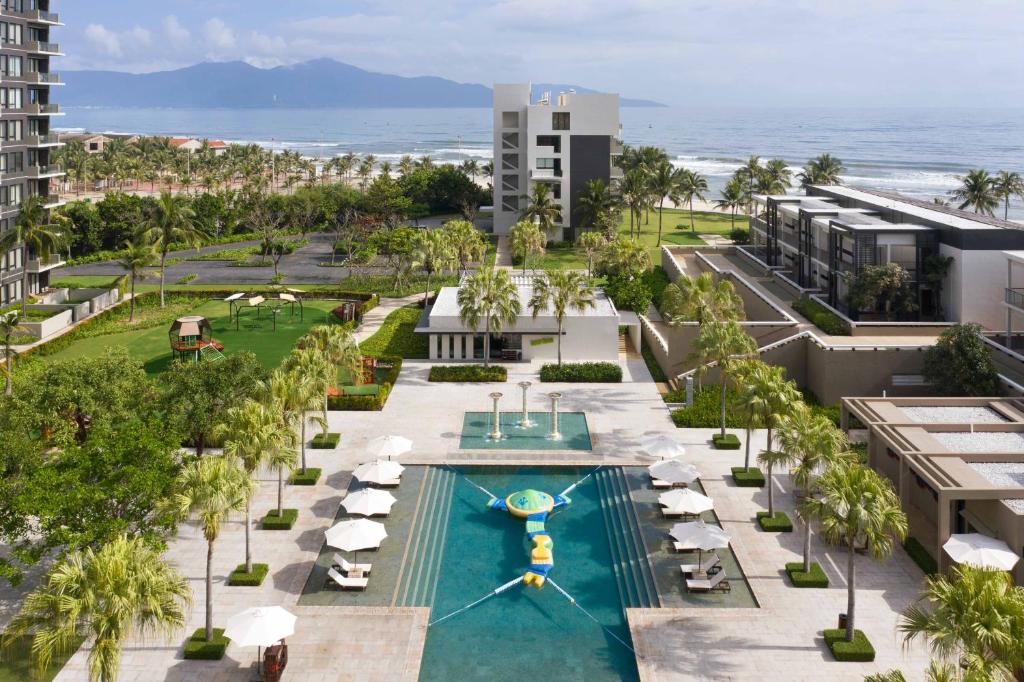
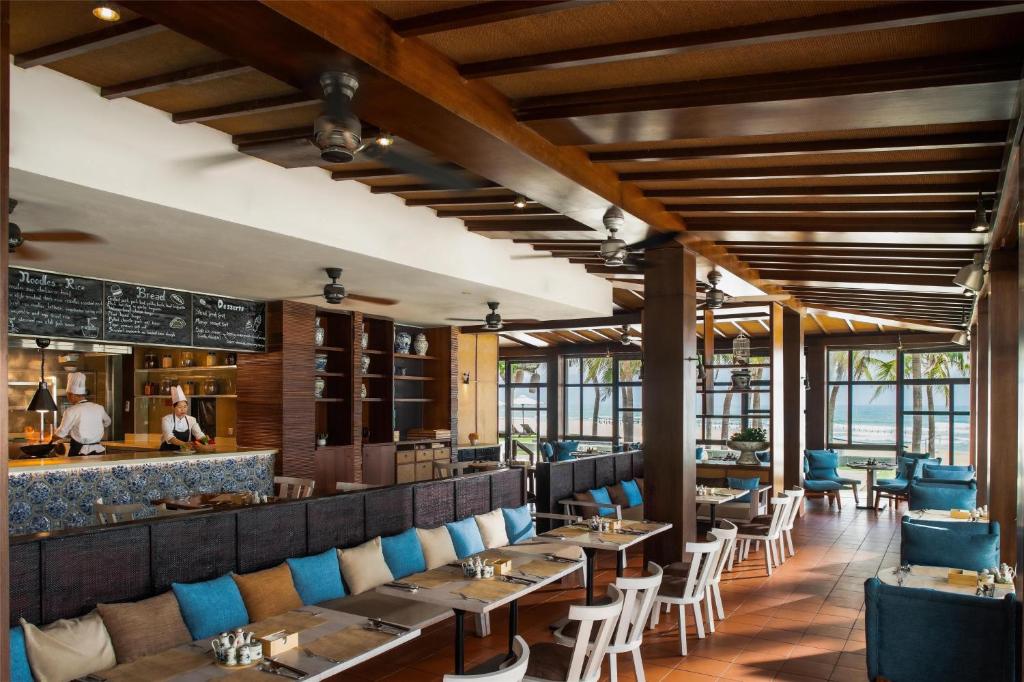
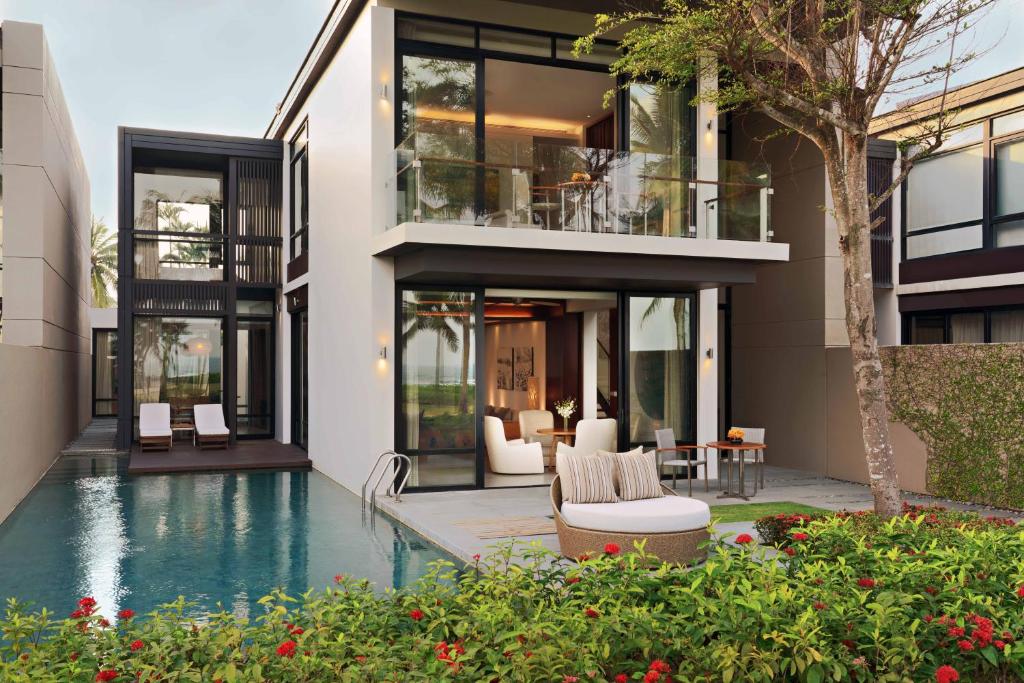
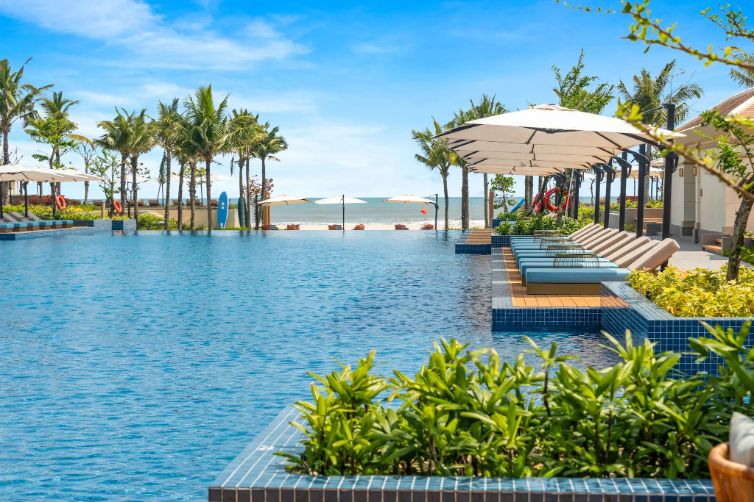
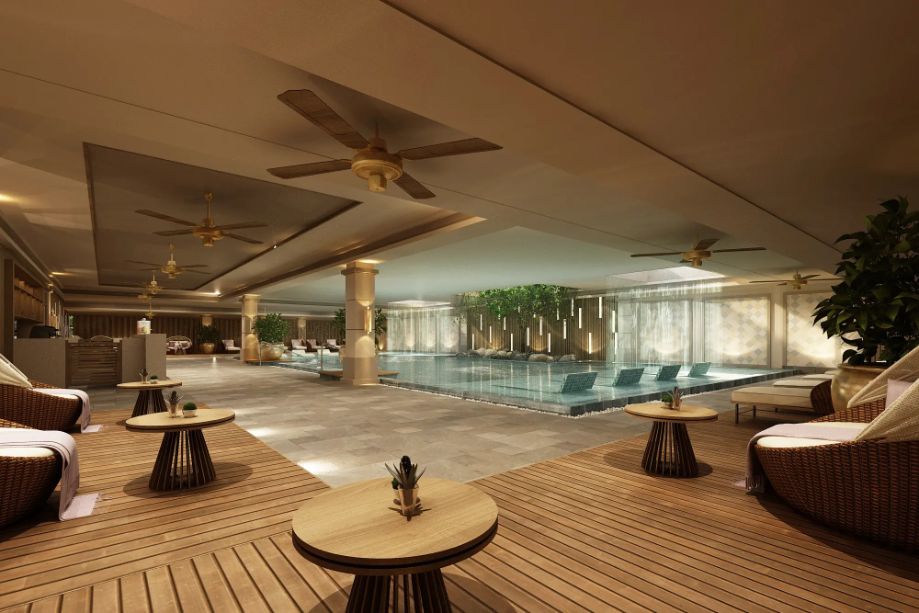
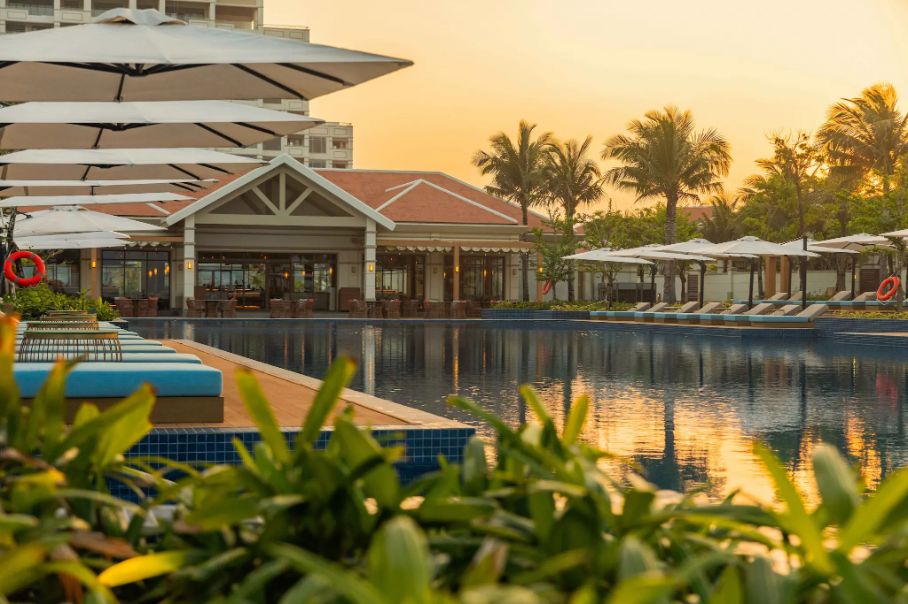
Mid-Range Resorts & Gated Communities
- オーシャンヴィラズ: The most popular choice for expat families. A huge, established community with a wide range of villa configurations (2-7 bedrooms). Safe, family-friendly, with great resort amenities. Quality varies greatly by owner. Prices range from $2,500 to $12,000/month. Read the Resident Guide for Ocean Villas
- Furama Villas: One of Da Nang’s original luxury resorts. The design is classic Indochine, and the location is fantastic. Still a highly sought-after address. 3-4 bedroom villas are common, starting at $3,500/month.
- The Point Villas: Modern 3-bedroom villas attached to the BRG Golf Course. Great value for money, but be very careful to choose a unit away from the massive construction site happening nearby. Prices start at $1,800/month.
- Montgomerie Links Residences: The leading golf course community. Beautiful 3-bedroom villas with private pools and lush gardens. Prices start at a very reasonable $1,800/month.
- Euro Village: The only true gated community within the city proper, located on the Han River with views of the Dragon Bridge. A mix of townhouses and large villas. Rarely available. Prices start from $1,200 for a townhouse and go up to $10,000 for a prime riverfront villa.
Where to Find Da Nang Long Term Rentals
The best ways to find a house for rent in Da Nang:
The most efficient and secure way to find a high-quality long-term rental in Da Nang is to work with a professional agency that understands the market and your specific needs.
At MVPベトナム, we are an expat-led agency with over 6 years of on-the-ground experience. We cut through the noise of the market to find you the best houses, luxury villas, and modern apartments. We handle the search, negotiation, and contract to ensure you get a fair price and a secure lease.
- Webサイト: www.mvpvietnam.com
- Email: contact@mvpvietnam.com
- Phone / WhatsApp: +84 846702884
However, if you prefer to handle the search yourself, here are the most common methods:
- Facebook Groups: The main hub is the “Da Nang & Hoi An Expats” group. Be prepared to sift through a high volume of listings from hundreds of agents. It’s a good starting point to see what’s available, but can be time-consuming and filled with outdated posts.
- The “Drive-Around” Method: This classic approach still works. Drive or walk through neighborhoods you like and look for “Cho Thuê” (For Rent) signs. This is how you can find hidden gems that are never listed online, though it requires time and often some Vietnamese language skills.
- Direct Building Inquiries: For large apartment buildings (like F Home, Hiyori, Azura), you can inquire at the reception. You will typically be referred to the building’s designated rental agent, who can only show you properties within that specific building.
Is Da Nang safe?
Yes, Da Nang is considered one of the safest cities in Vietnam for locals and foreigners. Violent crime is rare. Watch out for petty theft and always drive carefully due to unpredictable traffic.
Where to stay in Da Nang Vietnam?
Most expats and visitors choose to stay in My An or Son Tra districts for easy beach access, good apartments, and a vibrant social scene. Hai Chau is great for city living, while Nam Viet A and Hoa Xuan are quieter, family-friendly suburbs.
Best resorts in Da Nang?
Some of the best resorts in Da Nang include Hyatt Regency, Fusion Resort & Villas, Furama Villas, and The Five Resort & Villas. These offer luxury beachfront villas, resort amenities, and high security.
How much is cost for Da Nang long term rentals?
Long-term rentals in Da Nang are easily found through rental agencies such as MVP Vietnam, Facebook expat groups, and listing websites. You can rent studios, apartments, or villas for anywhere from $300/month to $7,000+/month, depending on the area and property type.
Is Da Nang a good place to live?
Yes, Da Nang is a great place to live for expats, families, and digital nomads. It has modern infrastructure, beautiful beaches, clean air, and a welcoming community—plus a much lower cost of living than major Western cities.
Can a US citizen live in Vietnam?
Yes, US citizens can live in Vietnam. Most start with a tourist visa, business visa, or work permit. Many expats stay long-term by renewing visas or doing visa runs, and Vietnam is welcoming to American residents.
How much money do you need to live in Da Nang?
You need about $900–$1,600 USD per month for a mid-range expat lifestyle: modern apartment, food, transport, and entertainment. You can live cheaply (~$600/month) or luxuriously ($4,000+/month) depending on your choices.
Where do most expats live in Da Nang?
Most expats live in My An (the “expat area”), Son Tra, and Hai Chau. My An has the biggest concentration of Western cafes, co-working spaces, and apartments close to the beach. Really accurate data is not available.
Is $1,000 USD a good salary in Vietnam?
$1,000 USD per month is enough for a single person to live comfortably in Da Nang, especially if you rent a basic apartment and eat local food. Western comforts, social activities, or premium housing will cost more.
When should I avoid Da Nang?
Avoid Da Nang in October and November during peak rainy/typhoon season. Some years see heavy storms and flooding; it’s not ideal for travel or beach activities.
Are Vietnamese friendly to Americans?
Yes, Vietnamese people are generally very friendly to Americans and all foreigners. Warm hospitality is a strong part of the culture, especially in tourism hubs like Da Nang.
Is Da Nang good for digital nomads?
Yes, Da Nang is an excellent city for digital nomads: fast internet, lots of cafes and co-working spaces, support networks, community events and easy access to leisure activities. The cost of living and international connectivity makes it a favorite spot for digital nomads in Asia
Where do digital nomads live in Vietnam?
Digital nomads mostly live in Da Nang (My An area), Ho Chi Minh City (District 1 and Thao Dien), Hanoi (Tay Ho), and Hoi An. Each offers a mix of modern amenities and networking options.
How much does it cost to live in Vietnam as a digital nomad?
Living costs as a digital nomad in Vietnam typically range from $600 to $2000 USD/month, including rent, food, workspaces, and entertainment. It all depends on your lifestyle choices.
How much is 1 month rent in Vietnam?
Monthly rent for an apartment in Vietnam starts from $200–$300 for a basic unit in a local area. Expats pay $350–$1000 for modern 1–2 bedroom apartments in popular areas. Luxury villas or condos cost upwards of $2,000/month. Beach front, super luxury villas can reach $9,000 to $16,000 for 5-6 bedrooms.
Can a foreigner rent a house in Vietnam?
Yes, foreigners can rent a house in Vietnam provided they have a valid visa. You can rent for as long as your visa permits; just remember to update your landlord and the local police with each visa renewal for registration.
Does Da Nang have an old town?
No, Da Nang doesn’t have an “old town” like Hoi An or Hanoi. The city center is modern, while the historic ancient town you see in photos is actually Hoi An, just a 45-minute drive south of Da Nang.
Does Da Nang have a casino?
Yes, Da Nang has several casinos, including Crown International Club (inside Crowne Plaza) and the Furama Resort Casino. Most casinos are open to foreigners with valid passports.

